Espoo Museum of Modern Art
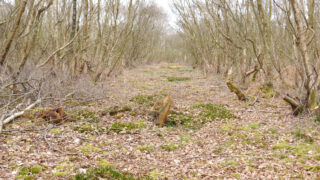
Being With video work by Falin & Felcey, 2021.
Material for the video has been recorded in following locations:
River Bollin, Cheshire, UK; Spode factory site, Stoke-on-Trent UK; Keramia Oy, Mjösund FIN.
DWELLING
by Priska Falin & Helen Felcey
We invite you to take part in Dwelling, an online workshop to support making and connecting. The exercises offered below can be explored in any order, and you might choose only one or two. You can take part at any time, from anywhere, as many times as you wish. Dwelling is open to everyone!
This online workshop, called Dwelling is part of Priska Falin’s and Helen Felcey’s work for the exhibition Ceramics Facing the New.
Falin & Felcey’s work concentrates on the tactile experiences of clay as an embodied material. Through a simple process of pebble making, Falin & Felcey bring forward different aspects of material experience that begin to reveal how interdependent we are as humans. The subjective experience becomes an interaction with the world through the experiential material encounter.
Dwelling in making, with the material in our hands, we become aware of the material world that we are a part of. We humans are dependent on the world around us – a world that can live on, far beyond our own existence.
Share your responses by using the hashtag #oleilla
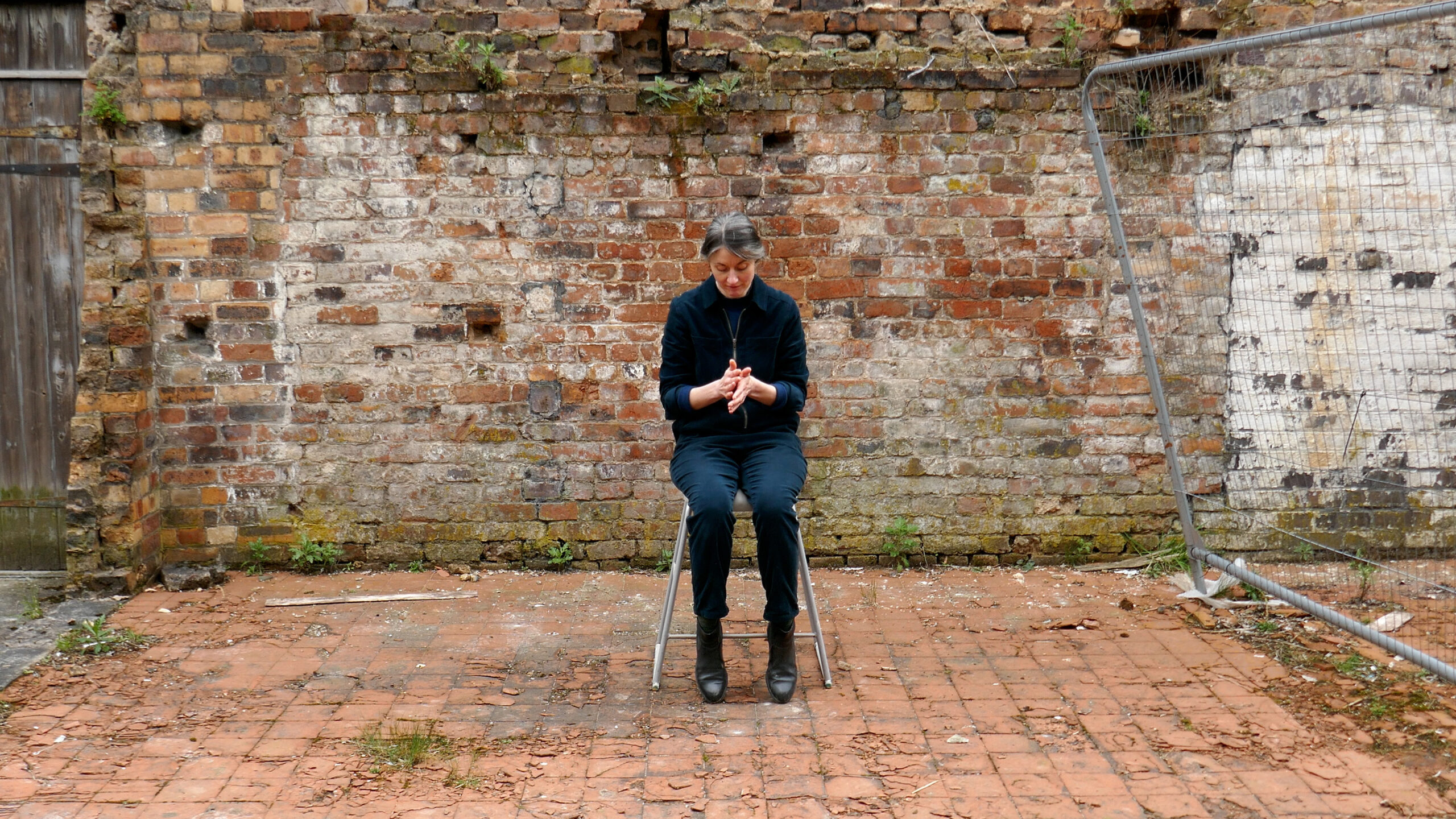
An Unconventional Approach to Making
Through Dwelling, we encourage you to tune into your tactile world – from the subtle light in your home, to the mossy woodland floor and the clay in the palm of your hand.
Dwelling in making is about staying with the tactile feel of the clay, without the need to reach an outcome or end result. With the clay held in our hands, the aim is to feel the material and to explore the tactile experience within the body. Our subtle sense perception involves both our mind and the physicality of the body – a mind-body unity in constant exchange with the living world.
Dwelling also implies that we humans are dwellers and we create spaces and places to be and live within. Dwelling can also be understood as doing, we dwell upon something, stay with a thought, spend time and give time. However, the current times that we live in often seem to be supporting the opposite; there is a need for progress defined by outcomes and efficiency. In Dwelling, we seek a different kind of progress; a movement towards personal experiences.
EXERCISES
We offer three exercises: Tactility Walks, Pebble Making and Abiding Place. There are no hard and fast rules to these exercises; they are yours to play with. You don’t need to follow the order, and you may wish to just try one of the exercises. These exercises are about bringing attention to your senses, your personal experiences of the world around you, and of the feel of making.
1. Tactility Walks
Take a short walk, anywhere you choose. Perhaps just out on the street, or to a local nature area. Begin to tune in to your embodied tactile perception, come back to your body, allow yourself to slow down.
Go deeper into your surrounding wilderness using your embodied tactile perception, what do you want to touch? Stop and look around you, what do you see that makes you want to touch it? Why do you want to touch it? Does it feel the way you thought it would? Go deeper into the ‘wild’ only using the willingness to touch as a guiding motivation.
During this walk, try to focus solely on the experience, without judgments or following thoughts of what this might produce. Sometime after your walk (perhaps in the evening, if you walked in the morning), bring your experience to mind and note down some simple, gentle observations about your experience.
Embodied Tactility
Exploring embodied tactility involves turning our focus to our sense perception, a perception that is very much part of our everyday lives. Tactility is the first sense that develops when we are born. Early life experiences are embodied within us; our bodies remember how it feels to touch a smooth surface that has been warmed by the sun; they remember who we are, where we have grown up and where we are in this world.
In order to focus on our sense perception and understand how it works, it is useful to find a slower rhythm that allows a deeper concentration on our bodily being. During the tactility walks, whilst we still use our vision, we allow our tactile sense to take the lead. Our vision is always informed by all of our subtler senses.
During the walks, look for things that provoke your tactile perception. Maybe you find a moss-covered rock that makes you want to touch the bright green textured surface. Explore this embodied tactile experience and let it guide you.
Share your responses by using the hashtag #oleilla
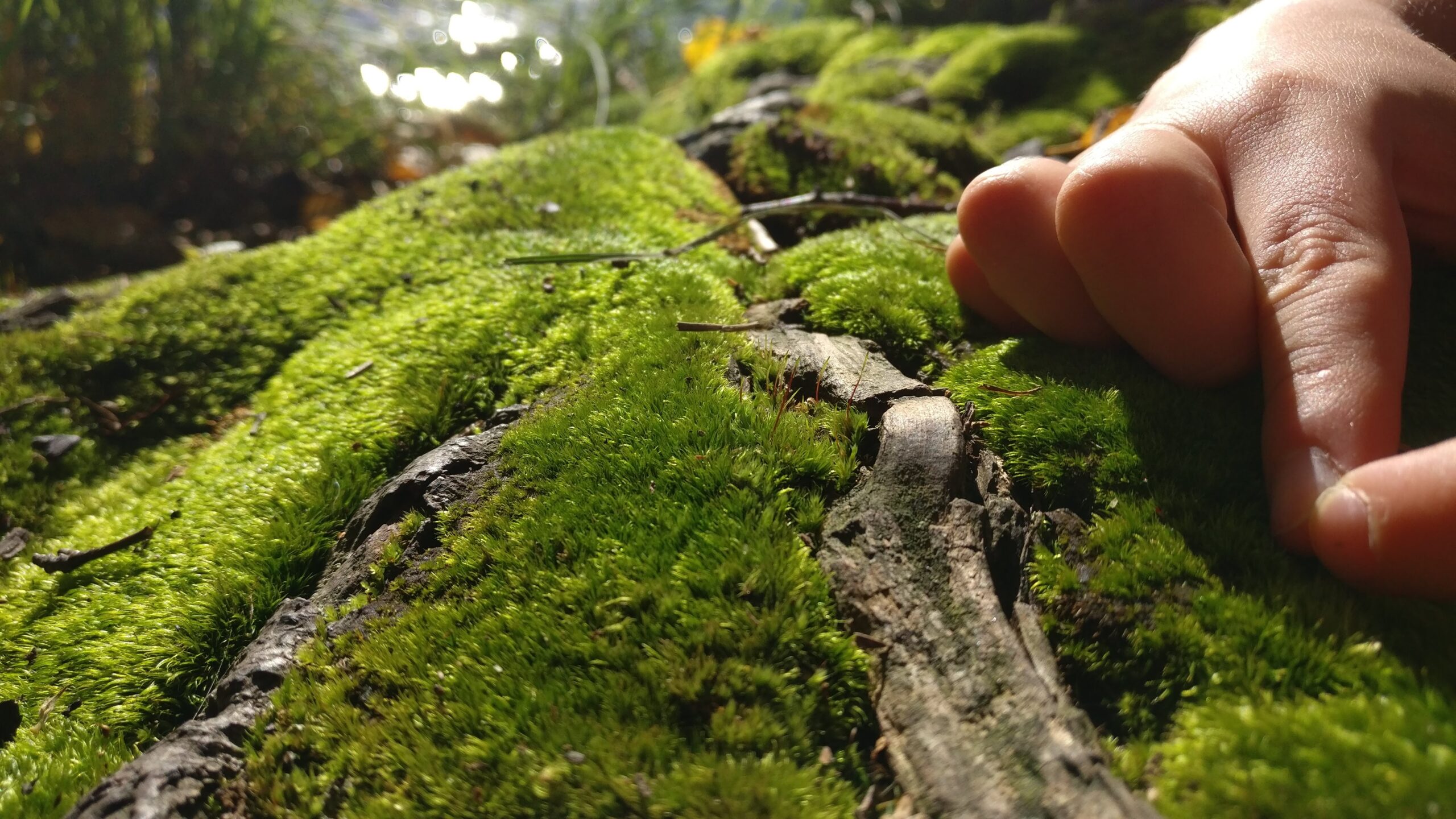
Creating tactile experiences. Image: Priska Falin, 2020.
2. Pebble Making
Have you ever made a clay pebble? The pebble asks very little of you. Only to roll the clay between your palms, to feel the quiet rhythm, to relax and stay with the experience.
Pebble making is an example of a process that one can start to dwell within and begin to have a sense of being with material. The process is a simple act of rolling a small quantity of clay between the palms. The act of rolling the clay in hands forms the pebble, not the will that often directs the making. Feeling the tactile clay, understanding the movement of the hands and responding to the clay’s qualities moment by moment feel instinctive and natural. The end result is an anonymous pebble like form that is there to simply remind you of this experience.
For pebble making at home, you can try different materials such as plasticine clay, dough or air-drying clay for example. You can also try to find wild clay from your home surroundings and sandy soil also works well if you can locate fine grained sand. By trying out different materials you can gain more nuanced experiences through the different tactile feels that the materials have and how they react to touching and forming.
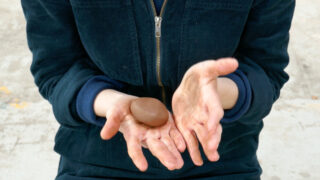
Feeling the qualities of clay, rolling a bit of clay between the palms – making a pebble.
Video: Helen Felcey & Philippa Wood, Stoke-on-Trent, UK, 2021.
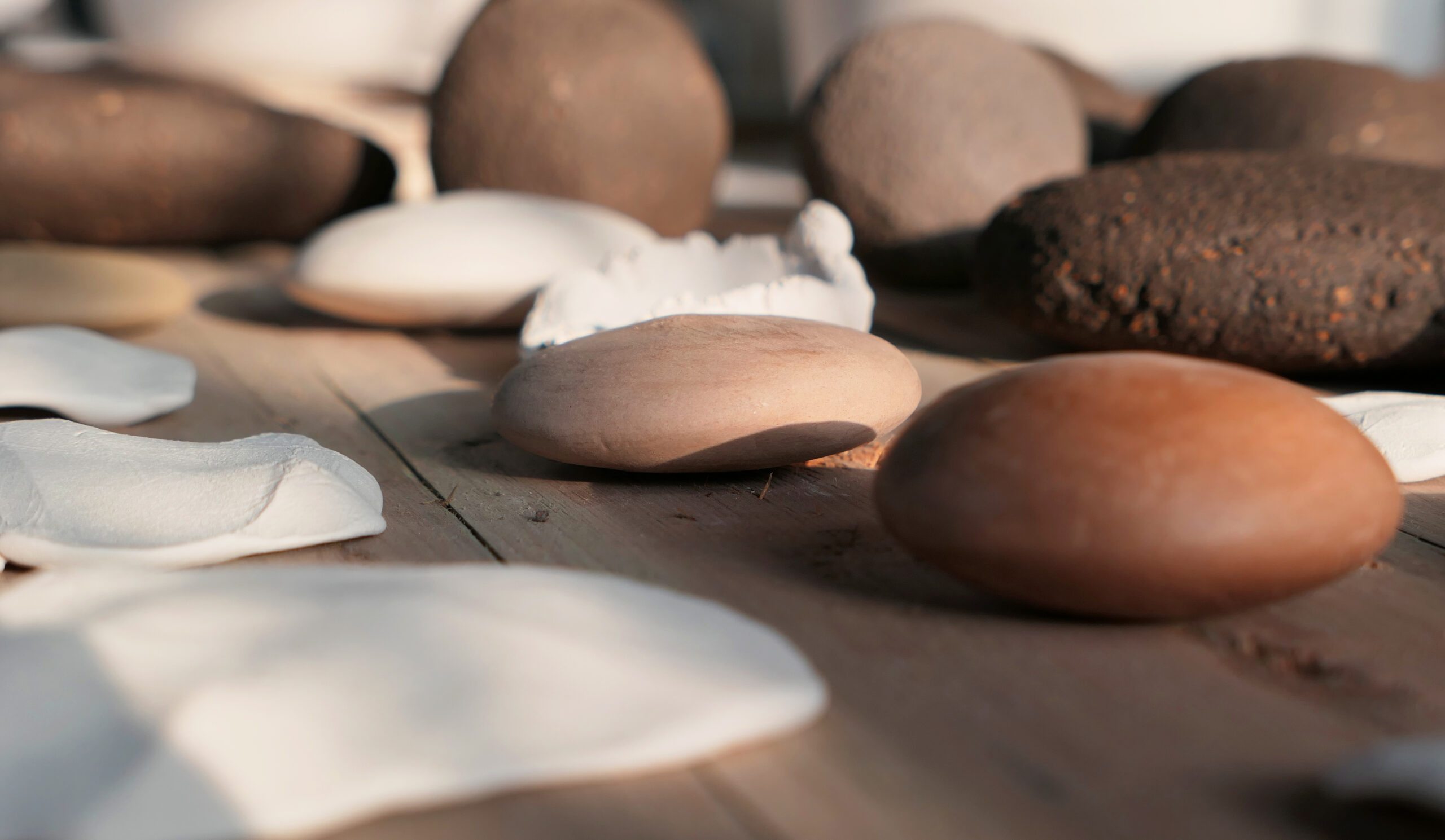
Feeling clay, making pebbles. Image: Priska Falin, 2018.
Experiencing muteness in the tactile experience
The tactile experience is unspoken by nature. Whilst we might try to describe it in words, often our everyday language can struggle to capture the experience. As we allow the language to die down, we begin to notice what this experience feels like – qualities of tactility, subtle movement and rhythm. Staying within the experience we can observe quietly; perhaps we feel some flickers of familiarity. The softness of the clay and the simple rotation within the palm over and over encourages to ‘stay’ – within the palm, with the clay, with the experience.
In this kind of tactile experience, where the attention is directed towards the body and feelings of the material in hands, the experience can be explored through understanding the making as mute. The verbal definition is not of importance here. It is about experiencing the muteness in the tactile experience, seeking for that dimension in our being that goes unnoticed.
Share your responses by using the hashtag #oleilla
3. Abiding Place
Tune in to your personal experience of a place; a place where you feel a sense of connection. Spend some time in this place making a video recording. As your camera captures your surroundings, breathe, allow yourself to be there too, experiencing and feeling every moment as it passes.
Seek out a location that you find you have connections with. It can be a location that you have come across during previous walks, or you might look for a new place. It’s important that you enjoy spending time in this place and feel that you have some kind of connection to it, perhaps just a feeling of enjoyment that makes you want to stop and spend some time in that particular spot. Once you have found your location, set up your camera or your mobile phone next to you and take a video, capturing the view or landscape you wish to look towards. The time to sit and be with the recording is 3 minutes. This recording will be capturing that 3-minute experience that you will be having while sitting in that location. Don’t talk or do anything; just try to experience that time just by being there.
Afterwards coming back to your home spend a little time looking into the video and reflect on your experience. What made you choose that particular location; how did you connect to it?
Share your responses by using the hashtag #oleilla
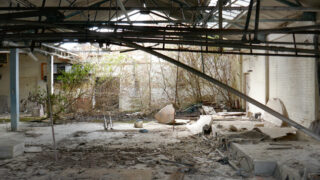
Abiding Place by Helen Felcey, 2021
Being in the landscape, experiencing the time
This video exercise offers you a means to begin dwelling in our environment, in the landscape of your choice. With the time spent in that location, being still during the recording, allow your attention to rest on the sensations of this place. During the 3 minutes, it is possible to inhale and exhale the inner and outer aspects of your experience: is it the visual of this place that makes you want to be there? Or is it the feeling that you have when you’re in that place? Where do you feel the sense of enjoyment that enables you to rest there, to spend time and even choose to come back to that spot again and again?
BEING WITH
An Installation at EMMA
This is a space for experiencing the process of creating a pebble through ‘feeling’ the tactility of the clay as you roll and press this small mound of earth within your palms. Sit down, take the clay in your hands, let go of thinking of the ‘outcome’, focus instead on your personal connections to the material and making.
Whilst you sit and make, you might be drawn into the different surroundings shown within the video-work; the ebb and flow of the river, the clay in our hands, the mechanical movements of the factory site.
On the tiled floor around you are many pebbles made by others, slowly layering within a factory of a different kind. Some are fired and shiny, others are fresh and soft. We invite you to offer your own pebble to this evolving space.
Being With installation at EMMA. Falin & Felcey, 2021. Images: Ari Karttunen / EMMA.
PERSPECTIVES TO DWELL UPON
When we dwell, we become aware of the material world that we are a part of. We are dependent on the world around us – a world that can live on, far beyond our own existence. Take time, to contemplate, to know, feel and appreciate the connections.
1. Tactile Experience
The first sense that develops in humans is the capacity to touch, yet vision is the main sense that we rely on, especially as adults. In fact, the human–made world has become mostly built for our vision. What would the world be like if we focused on the tactile sense, if we placed more emphasis on how things feel and navigated the world through touch? Examining our capacity for touch within the hands, we can learn that our fingertips are the most sensitive parts; it is through the fingertips that we are able to feel ‘in detail’. The centre of our hands, the palms, are connected to feeling and the heart. Gently touching the centre of palms can offer an immediate sense of this.

Feeling the pebble in the center of the palm. Image: Priska Falin, 2018
2. Material
The clay in your hands has gone through a long process of formation over millions of years to become this soft, malleable substance. Natural clay is a part of the vast elemental cycles of our rocky planet where over the millenia mountains become lakes, pebbles turn to particles and minerals combine to form a substance that we know as clay. Whilst we might feel ourselves to be seperate, we too are within this vast cycle, affected by the elements and closely intertwined with the material world around us.
3. Physical Effort
The physical aspects of making have gone through somewhat of a transformation in recent years. The far-reaching digitalization of our lives has changed the dynamics of ‘physical effort’ in a way that directly influences the human body. Where we were once more physically involved with the work – making, writing, meeting for conversation – we frequently find ourselves sitting in front of a screen. It is interesting to ask: how does this influence the value of physicality in making and the physicality of work in general?
4. Environment
Clay as a natural resource is part of our environment and the landscape we live in. Digging clay from the ground feels natural but looking into it in detail we can find microscopic particles of plastic and understand that the relatively short existence of humans on this planet have penetrated the surface and transformed the natural environment. When feeling the clay in hands, one can only wonder how much of it is natural? Is it healthy with good bacteria that supports your immune system or is it full of chemicals that are toxic?
5. Metaphors and Poems
As we find this pebble shaped clay in our hands, we might ask, what is it?
The great aeons of time, the incalculable particles and gradual movements and formations of this rocky planet are not visible to our eyes, and the time we have for observing is perhaps barely there, a small glimpse found in the duration of the movement of our pebble. How are we to understand the existence of a pebble?
In poems, the metaphorical use of words often creates an understanding that can be felt in our bodies, but in a way that combines all the living and the world together. In the poem which follows, Conversation with a Stone, the stone calls for a sense of taking part; in pursuit of taking part, we begin by being with. What can we understand through holding a pebble in our hands? What kind of conversation might we have with a stone?
Wislawa Szymborska:
Conversation with a Stone
I knock at the stone’s front door
“It’s only me, let me come in.
I want to enter your insides,
have a look around,
breathe my fill of you.”
“Go away,” says the stone.
“I’m shut tight.
Even if you break me to pieces,
we’ll all still be closed.
You can grind us to sand,
we still won’t let you in.”
I knock at the stone’s front door.
“It’s only me, let me come in.
I’ve come out of pure curiosity.
Only life can quench it.
I mean to stroll through your palace,
then go calling on a leaf, a drop of water.
I don’t have much time.
My mortality should touch you.”
“I’m made of stone,” says the stone.
“And must therefore keep a straight face.
Go away.
I don’t have the muscles to laugh.”
I knock at the stone’s front door.
“It’s only me, let me come in.
I hear you have great empty halls inside you,
unseen, their beauty in vain,
soundless, not echoing anyone’s steps.
Admit you don’t know them well yourself.
“Great and empty, true enough,” says the stone,
“but there isn’t any room.
Beautiful, perhaps, but not to the taste
of your poor senses.
You may get to know me but you’ll never know me through.
My whole surface is turned toward you,
all my insides turned away.”
I knock at the stone’s front door.
“It’s only me, let me come in.
I don’t seek refuge for eternity.
I’m not unhappy.
I’m not homeless.
My world is worth returning to.
I’ll enter and exit empty-handed.
And my proof I was there
will be only words,
which no one will believe.”
“You shall not enter,” says the stone.
“You lack the sense of taking part.
No other sense can make up for your missing sense of taking part.
Even sight heightened to become all-seeing
will do you no good without a sense of taking part.
You shall not enter, you have only a sense of what that sense should be,
only its seed, imagination.”
I knock at the stone’s front door.
“It’s only me, let me come in.
I haven’t got two thousand centuries,
so let me come under your roof.”
“If you don’t believe me,” says the stone,
“just ask the leaf, it will tell you the same.
Ask a drop of water, it will say what the leaf has said.
And, finally, ask a hair from your own head.
I am bursting from laughter, yes, laughter, vast laughter,
although I don’t know how to laugh.”
I knock at the stone’s front door.
“It’s only me, let me come in.
“I don’t have a door,” says the stone.
From Poems New and Collected: 1957-1997 by Wislawa Szymborska, translated from the Polish by Stanislaw Baranczak and Clare Cavanagh
Related reading
Falin, Priska & Oksanen, Pia. 2021. Ceramic pebbles as sensory tools: exploring the quality of muteness in tactile experience. Proceedings of the Art of Research Conference 2020. Research in Arts and Education.
Pallasmaa, Juhani. 2005. The Eyes of the Skin: Architecture and the Senses. John Wiley & Sons Ltd.
Szymborska, Wislawa. 2000. Poems, New and Collected, 1957 – 1997. Translated from the Polish by Stanislaw Baranczak and Clare Cavanagh. Harcourt.
In the making of this work, we are grateful for the support of:
Emil Aaltonen Foundation
Keramia Oy / Tiileri Oy
Spode Factory
EMMA – Espoo Museum of Modern Art